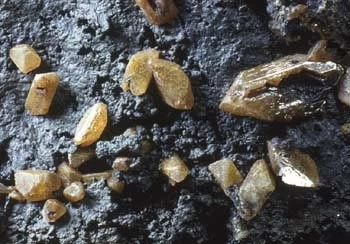Minerals first discovered in Wales
Anglesite crystals up to 10 mm in length from the type locality at Parys Mountain, Anglesey. Photo M.P. Cooper.
A 20 mm wide crystal of brookite from the type locality at Prenteg, Gwynedd. Photo M.P. Cooper
Scanning electron micrograph of prismatic cymrite crystals from the type locality at Benallt mine, Rhiw, Pen Llŷn, Gwynedd.
Powdery dickite coating dolomite from the type locality at Trwyn-Bychan, Anglesey. Photo M.P. Cooper
The type specimen of namuwite from Aberllyn mine, Betws-y-coed, Gwynedd.
Over 430 different mineral species occur in Wales, approximately ten percent of all those known. Eleven minerals were first discovered in Wales and have been named after famous Welsh geologists, mineralogists, places and even the Museum itself. These are:
- anglesite
- banalsite
- brammallite
- brinrobertsite
- brookite
- cymrite
- dickite
- lanthantite-(ce)
- namuwite
- pennantite and
- steverustite
Brookite, an oxide of titanium, was first discovered in north Wales in around 1809. It was named in 1825 in honour of the British crystallographer and mineralogist, Henry James Brooke (1771-1857) by the French mineralogist Armand Lévy.
In 1783 Reverend William Withering described a new species, plumbum (lead) mineralized by vitriolic acid and iron, occurring in, "immense quantity in the island of Anglesea". The name, anglesite, was later proposed for lead sulphate by the French mineralogist Francois Sulpice Beudant in 1832, in recognition of the original locality, and this name has been used ever since.
In 1930 a new clay mineral dickite was named in honour of the Scottish metallurgical chemist, Allan Brugh Dick (1833-1926) who had published a detailed account of its properties on material from Trwyn-Bychan, Anglesey.
Another clay mineral, brammallite, named after Alfred Brammall (1879-1954), formerly of the Department of Geology, Imperial College, London, was described in 1943 from Llandebie, Carmarthenshire.
During the 1940s extensive research was carried out at the manganese mines at Rhiw, Llŷn Peninsula, Gwynedd, where several new species were discovered at the Benallt mine. The first, banalsite, was named from its composition, barium (Ba), sodium (Na), aluminium (Al), silicate (Si).
The famous Welsh naturalist Thomas Pennant (1726-1798) was recognised in 1946 with a manganese chlorite mineral, pennantite. A new hydrated barium feldspar was named cymrite for Wales in 1949.
In 1982, a new zinc copper sulphate hydroxide hydrate was identified on an old museum specimen collected from the Aberllyn mine, near Betws-y-coed. It was given the name namuwite after the National Museum of Wales where the specimen is housed. The naming of a mineral after an institution is now considered inappropriate, but the name stands, making this a very unusual mineral.
In 1985 a new cerium-dominant lanthanite from Britannia mine on Snowdon, was described and named lanthanite-(Ce) .
A new clay mineral found near Bangor in Gwynedd was named brinrobertsite in 2002, in honour of Brinley Roberts of the University of London, who has published widely on the geology of North Wales.
The latest mineral to be discovered in Wales is a rare lead thiosulphate formed within mine dumps at a number of sites in Central Wales. It was named steverustite, in 2009, in honour of its discoverer, Steve Rust, a micromineral collector who has dedicated much of his life to identifying unusual post-mining minerals in the Central Wales Orefield.
To find out more about these and other Welsh minerals look at Amgueddfa Cymru's
Mineralogy of Wales website.




Comments - (1)